What is HIV and How Does It Affect the Body?
HIV is a virus that attacks the body’s immune system, specifically targeting CD4 cells (also known as T cells). Over time, if left untreated, HIV can weaken the immune system to the point where it struggles to fight off infections and diseases, leading to AIDS (Acquired Immunodeficiency Syndrome).
Key Facts About HIV:
-
HIV is transmitted through specific body fluids, including blood, semen, vaginal fluids, rectal fluids, and breast milk.
-
It cannot be spread through casual contact such as hugging, sharing food, or mosquito bites.
-
Early diagnosis and treatment are critical in managing the virus effectively.
Progress in HIV Treatment: Antiretroviral Therapy (ART)
The development of antiretroviral therapy (ART) has been a game-changer in the fight against HIV. ART does not cure HIV but helps suppress the virus, allowing individuals to lead healthy lives and reducing the risk of transmission.
How ART Works:
-
ART involves taking a combination of medications that prevent the virus from replicating in the body.
-
This helps maintain a low viral load, meaning the amount of HIV in the blood is minimal or undetectable.
Comparing HIV Treatment Methods: Pros and Cons
Below is a table comparing different HIV treatment approaches, highlighting the advantages and disadvantages of each:
|
Treatment Type
|
Pros
|
Cons
|
|
Antiretroviral Therapy (ART)
|
Suppresses virus to undetectable levels; improves quality of life; reduces transmission risk
|
Requires strict adherence; potential side effects
|
|
Pre-Exposure Prophylaxis (PrEP)
|
Prevents HIV infection in high-risk individuals; highly effective when used consistently
|
Not suitable for those already infected; costly in some regions
|
|
Post-Exposure Prophylaxis (PEP)
|
Prevents HIV infection after potential exposure; must be taken within 72 hours
|
Time-sensitive; not a substitute for regular prevention
|
|
HIV Vaccine (experimental)
|
Offers long-term prevention potential; reduces global infection rates (if successful)
|
Still under development; not yet widely available
|
Prevention Strategies: Reducing the Risk of HIV Transmission
Preventing HIV is as important as managing it. By following preventive measures, individuals can significantly reduce their risk of contracting or transmitting the virus.
Key Prevention Methods:
-
Condom Use: Consistent and correct use of condoms reduces the risk of HIV infection during sexual activity.
-
Pre-Exposure Prophylaxis (PrEP): A medication for HIV-negative individuals at high risk of exposure.
-
Post-Exposure Prophylaxis (PEP): Emergency medication taken within 72 hours after potential exposure.
-
Needle Exchange Programs: These programs reduce the risk of HIV transmission among people who inject drugs.
-
Regular Testing: Early detection through routine testing helps prevent further transmission and allows for timely treatment.
Living with HIV: Breaking Stigma and Improving Quality of Life
Thanks to advancements in medical science, people living with HIV can now live long, fulfilling lives. However, societal stigma and discrimination remain major challenges.
Ways to Support People Living with HIV:
-
Education and Awareness: Helping others understand that HIV is a manageable condition reduces fear and prejudice.
-
Support Groups: Connecting with others who share similar experiences can provide emotional and psychological support.
-
Access to Resources: Ensuring access to healthcare, medication, and counseling is vital.
Common Myths vs. Facts About HIV
There are still many misconceptions about HIV. Let’s address some of the most common myths:
-
Myth: HIV is a death sentence. Fact: With ART, people with HIV can live long, healthy lives.
-
Myth: You can get HIV from casual contact. Fact: HIV is not spread through hugging, sharing utensils, or casual contact.
-
Myth: HIV only affects certain groups of people. Fact: HIV can affect anyone, regardless of gender, age, or sexual orientation.
FAQs About HIV
-
Can HIV be cured?
Currently, there is no cure for HIV. However, treatments like ART allow people to manage the virus effectively.
-
What is the difference between HIV and AIDS?
HIV is the virus that attacks the immune system, while AIDS is the advanced stage of HIV infection when the immune system is severely damaged.
-
How effective is ART?
When taken consistently, ART can suppress the virus to undetectable levels, meaning it cannot be transmitted to others through sexual contact.
-
Is HIV testing painful?
No, HIV testing usually involves a simple blood test or oral swab and is quick and painless.
-
Who should consider taking PrEP?
PrEP is recommended for individuals at high risk of HIV exposure, such as those with HIV-positive partners or people who inject drugs.
-
How can I support someone living with HIV?
Offer emotional support, educate yourself about the condition, and challenge any stigma or discrimination you encounter.
Global Efforts to Combat HIV
Governments, organizations, and researchers worldwide are working tirelessly to combat HIV and AIDS. Initiatives include:
-
UNAIDS: A global program aiming to end the AIDS epidemic by 2030.
-
HIV Vaccine Research: Ongoing efforts to develop a vaccine that provides long-term protection.
-
Community Outreach Programs: Providing education and healthcare resources to vulnerable populations.
HIV is no longer the life-threatening condition it once was, thanks to scientific advancements and increased awareness. Early testing, effective treatment, and preventive measures are key to managing the virus and reducing its global impact. By continuing to educate ourselves and support those living with HIV, we can work toward a healthier, more inclusive future.
References:
-
-
-

